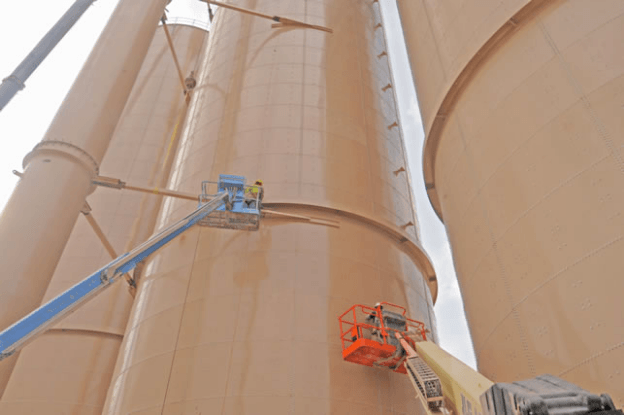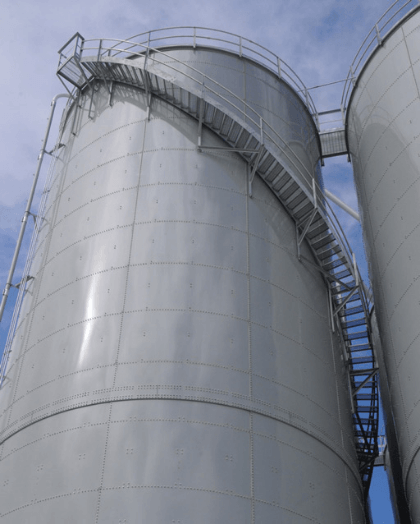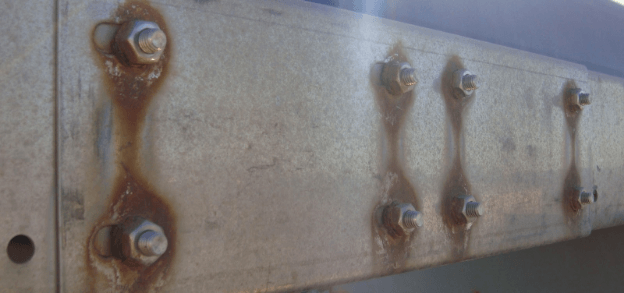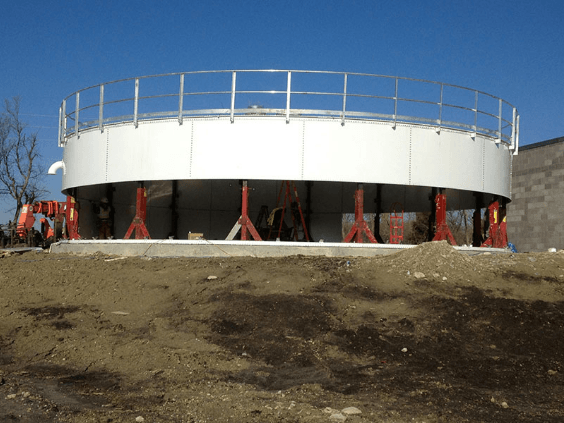A Conversation with Bill Alumbaugh, Director of Engineering at Tarsco Bolted Tanks


What do you know about huge tanks and vessels found at power plants, industrial sites, and chemical storage facilities? When we asked ourselves these same questions, we concluded we knew next to nothing about these humongous objects.
We wanted to know things like how an engineer works with their team, which materials are needed to fabricate a tank, when vendors are outsourced, and why types of tags and nameplates matter. So we decided to talk with an engineer whose expertise is as vast as the insides of these large vessels.
We got on a phone call with Bill Alumbaugh, Director of Engineering for Tarsco Bolted Tank. While conducting preliminary research on the company’s website, I realized it was difficult for a novice like myself to immediately grasp the industry and their provided solutions. The company specializes in tank fabrication, construction, repair, maintenance, and insulation.

What does it mean to specialize in ‘bolted and welded storage tank systems’? Bill’s even-tempered tone reminded me of a past Algebra professor who had a knack for relaying information with a mixture of succinct focus and comic relief.
We started the conversation owning up to the fact that we knew very little about Bill’s industry or tanks. Immediately, we asked about the practical needs the products served. Bill was mindful in humbly distilling his knowledge in a way that could be easily understood.
“A tank is nothing more than a storage container,” he stated with a Southern drawl. Providing more detail about when a tank is needed and when it’s not, he reminded us that we as Americans live in an “on-demand society.” He went on to point out, “We want things when we want them.” I found that to be an interesting way for an engineer to validate the need for his expertise.
Next, we inquired about how the team designs a tank. Again, Bill took a few seconds to explain in terms you and I can understand. “Each tank is unique depending on what’s going in it. You need to know specifics. Does it hold petroleum, sand, or water? Is the material dry or wet? How is a client going to get the materials in it (the tank) and out of it?”
In America all structures – buildings, houses, tanks, etc, are designed according to the International Building Code (IBC). Explaining further, Bill mentioned a number of acronyms related to organizations that mandate codes for specific contents (water, petroleum, etc.) I felt overwhelmed. However, as if he could sense the moisture behind my ears, Bill brought the conversation back with laser focus. “Basically, once we know what’s going in the tank, we move forward in adhering to codes regarding the design.”

We asked about the ‘aesthetics’ of the design. Bill laughed before explaining owners are tolerant and understanding as to how an ‘aged’ tank looks, one that has been weathered and worn by usage. But, when the tanks are brand new, ‘presentation’ is a very big deal.
He likened presenting a new tank to a salesperson steering a buyer’s attention toward a new car; if the car has a minor scratch or imperfection, it speaks volumes about the quality of dealership and the integrity of the salesperson.
We steered the conversation to the materials needed to meet the demands of the tank, specifically for keeping outside materials from getting inside. Bill brought us back to a recurring theme of his design process. “We have to think about what goes in the tank,”and went on to say, “The materials we use to design the tank must have excellent resistance to what is inside the tank.”
“If the exterior is damaged, it makes a poor impression, but more importantly, it could mean the tank allows outside elements (rain, oxygen, etc) inside. Contained elements can be compromised by outside factors, and depending on what’s inside, a leak could be hazardous to nearby people and environments.” Again, Bill was concise in explaining an integral goal: “Keep the contents in the tank and everything else on the outside.”
We wanted to know more about the outside, specifically labels and tags affixed to tanks. “The labeling has to be maintained,” Bill explained. “For example, a label may have a protective adhesive yet that adhesive cannot pose threat to the tank itself.” We came to realize the materials that produce labels are hugely important. “Stainless steel actually eats carbon steel, so we have to make sure our materials are compatible with the tank.”

We grew curious about the actual buying process and vetting of outsourced materials. Bill chuckled before stating, “Actually it’s real simple. We tell the purchaser what we know, what we need to complete a specific job, and they go out and procure it. 90-95% of sales will be based on price. Once we indicate the product type, it comes down to who can supply it the cheapest and quickest.”
“Once you’re on an approved vendor’s list it comes down to cost. Then it goes into extraneous conditions. For example, if I’m in a situation where I need quality fast and a vendor comes through, they’ll get priority next time. If a vendor is hard to work with or has a slow turnaround time, they’ll move farther down the list,” He reminded us that when it comes to quality, his team gives no quarter. “If a supplier’s product does not meet its function, they are dropped from the list.”
In redirecting the focus of another buying process question, Bill voiced, “An engineer is needed to put the tank together and ensure it meets requirements. We as a company are goingto do what we say we are going to do. We want to underpromise and overdeliver.”
“The engineer is basically the one who chooses the codes and applications and performs the calculations. Tanks are manufactured under my supervision and guidance. I’m supposed to know enough about codes, welding, materials, etc. An engineer, if he is worth his salt, is always willing to listen to design insights. But the engineer is responsible for turning those ideas into reality.”
We were wondering if these tanks were ‘under warranty’ for a specific time period. Bill told us the tanks typically last 10-20 years or more but they are not under manufacture warranty throughout the lifetime of the product. In particular circumstances, manufacturers may address repairs, maintenance, and troubleshoot unique issues.
We asked of the repercussions of failed products or aspects that do not meet the demands of the buyer. Bill gave a steely, “We all carry our reputations everywhere we go” as a response. “If we provide poor performance then our reputation will precede us and we lose opportunities to provide quotes for future jobs.”

We then focused the conversation on tags and labels. We wanted to know about the coveted attributes of such implements. Bill explained, “Again, the types of tags will depend on the tank and its contents. Basically, a tag needs to be legible, identifiable, and withstand its environment.” We want to note that MPC’s Metalphoto anodized aluminum is a material many engineers rely on for labels and tags that remain readable for decades.
Bill also voiced that signs and tags that are in the vicinity but not on the tank were not of high concern, but regarding those placed on the tank, he reminded us of how particular metals interact. “I don’t want something on there that’s going to eat my tank.”
Since Bill’s company uses bolts to fabricate tanks, corrosion and how different metals influenceone another is an issue. For example, stainless steel eats away at carbon steel, and in some cases, metals corrode faster when combined with other metals and conditions (galvanic corrosion).
At this point, we were amazed to discover it may require the design and fabrication of thousands of parts to create a tank. We were curious as to how long (end to end) the process took. Bill told us that it typically takes 8-12 weeks from the time the contract is signed to the completion of a tank. We were taken aback, assuming it would take more than a few months to complete the design, research codes, manufacture parts, contact vendors, and make it all come together.
We had talked with Bill for close to an hour at this point and had to let him get on his way. He closed the conversation as graciously as he first introduced himself and we were left in the wake of our newfound knowledge and wonder regarding, as Bill put it, “nothing more than a storage container.”
To find out more about MPC’s products, materials and applications start here.
Image credits
www.tfwarren.com/companies/tarsco/tarsco-bolted-tank
https://en.wikipedia.org/wiki/Galvanic_corrosion
Our sales engineers are experts in automatic asset tracking, tagging and identification,a nd can answer all your questions. Get in touch now.
Lets Talk ›